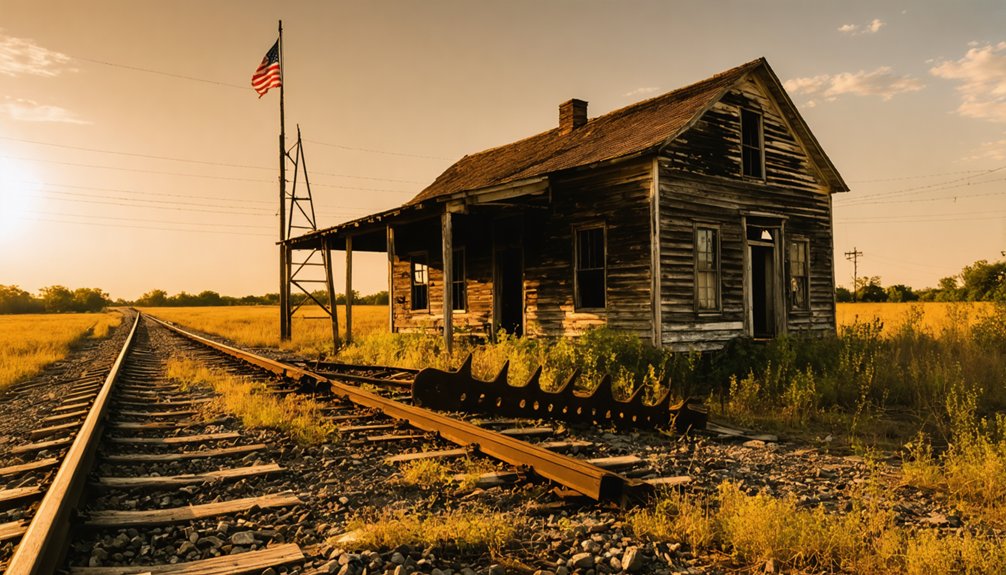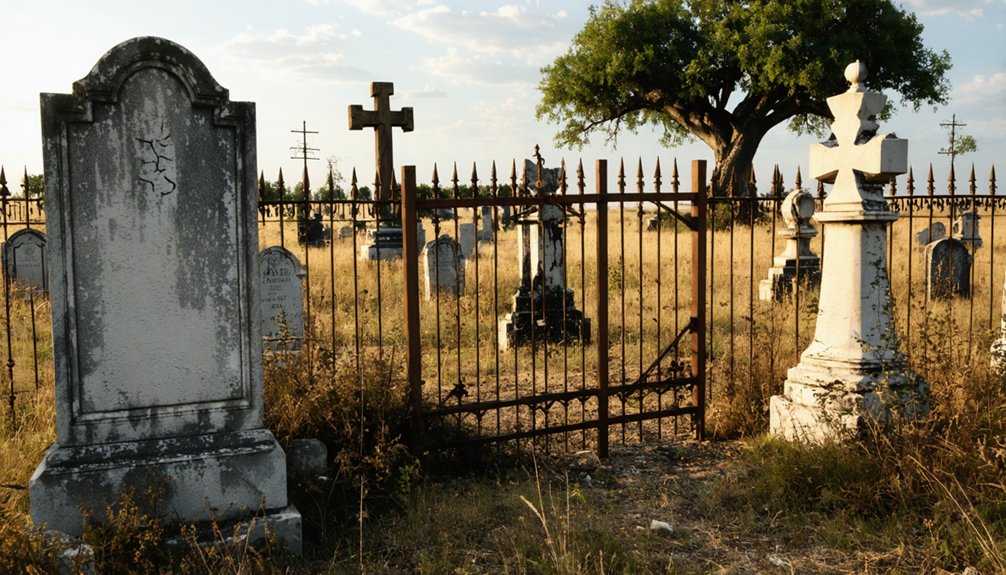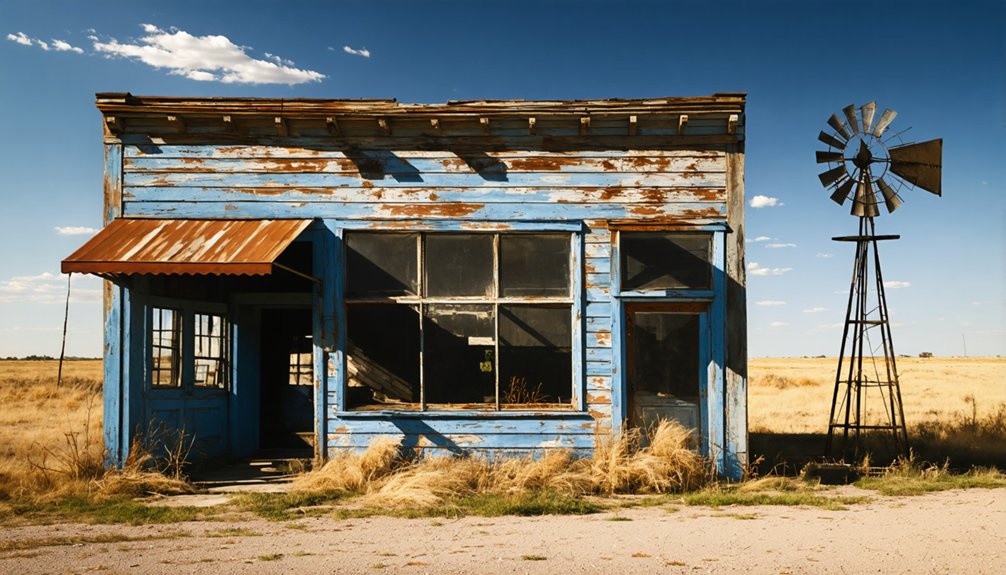You’ll find Sterling’s haunting remains along the Brazos River in Robertson County, Texas. This frontier settlement began as an 1836 land grant and grew into a thriving community under Captain W.S. Sterling’s leadership. The town flourished with churches, stores, and a Masonic Lodge until the Houston & Texas Central Railway bypassed it in 1867. Today, the eleven-acre Sterling Cemetery preserves the compelling stories of these ambitious pioneers.
Key Takeaways
- Sterling became a ghost town after being bypassed by the Houston & Texas Central Railway in 1867, causing businesses to relocate.
- The town initially thrived due to its Brazos River location but declined when rail transportation became vital for economic survival.
- All that remains of the original settlement is the historic Sterling Cemetery, spanning eleven acres of Brazos River bottomland.
- The town’s demise was accelerated when local businesses moved closer to railway depots, despite efforts to establish a local depot.
- Sterling’s history is preserved through its cemetery, which documents the area’s frontier life, Indian conflicts, and Civil War period.
Origins and Early Settlement
While the land that would become Sterling began as an 1836 grant to A.J. Webb in Robertson County’s Brazos River bottom, it wasn’t until Judge Robert Calvert’s purchase in 1850 that settlement truly took root.
You’ll find that early pioneers faced significant challenges, including raids from native tribes like the Comanche, Lipan Apache, and Kiowa.
The area’s first extended white settlement came with Captain W.S. Sterling, a buffalo hunter and Indian fighter who’d later have both the town and county named in his honor. He earned widespread respect as a U.S. Marshal before meeting his fate at the hands of Apache Indians in Arizona.
Captain W.S. Sterling established the first lasting settlement here, leaving his mark as both a hunter and the region’s future namesake.
Despite the dangers, families were drawn to the fertile land, establishing a vibrant community complete with stores, churches, and a Masonic Lodge. The Cumberland Presbyterian Church became a prominent landmark, constructed by slaves using local walnut lumber.
The town’s name originally honored Sterling Clack Robertson, an empresario who’d brought 600 families to Mexican Texas.
The Rise of a Frontier Community
You’ll find Sterling’s early frontier growth was shaped by its strategic position along the fertile Brazos River banks, where pioneering families established prosperous farms and ranches.
The community’s development accelerated with the establishment of essential institutions, including a post office, mercantile stores, and the Cumberland Presbyterian Church.
Your understanding of Sterling’s rise wouldn’t be complete without noting how the Masonic Lodge became a cornerstone of social organization, reflecting the town’s transformation from a scattered settlement into a structured frontier community.
The area’s original appeal to settlers centered on good grassland, which supported a thriving livestock industry before oil discovery changed the region’s economic focus.
Early ranchers faced significant challenges during the drought of 1883, which sparked violent fence-cutting wars as settlers competed for limited grazing lands.
Early Settlement Patterns
As Texas expanded its frontier in the mid-1800s, Sterling emerged from a land grant originally issued to A.J. Webb in 1836. Judge Robert Calvert’s purchase of the land in 1850 sparked an influx of pioneering families seeking opportunity in this untamed territory.
You’ll find that early settlement patterns revolved around essential community needs. Alongside Calvert, settlers like J.S. McLendon and Jared Steele established roots, building mercantile stores, churches, and a Masonic Lodge. The Cumberland Presbyterian Church, constructed from local walnut wood, became a symbol of their determination. The town’s vibrant social life included church revivals and dances.
Settlement challenges were constant. You’d have faced Indian raids, disease outbreaks, and the harsh realities of frontier life. Local ranchers frequently clashed with Comanche and Apache tribes who had long inhabited the region.
Yet the fertile Brazos River bottom land kept drawing settlers, who transformed the wilderness into a growing community named after Sterling Clack Robertson.
River Location Advantages
When Sterling’s pioneers selected their settlement site near the North Concho River, they secured an essential lifeline for their frontier community.
You’ll find their strategic choice paid off, as the river provided critical water resources in a region where water scarcity could make or break a settlement’s survival.
The North Concho’s path offered natural river navigation routes, connecting Sterling to crucial trade networks and military outposts.
You can trace how the waterway influenced the placement of major ranching operations like the MS Ranch and Half Circle S Ranch, while also providing defendable positions against threats.
The river’s presence transformed the Edwards Plateau into viable ranchland, supporting cattle operations that would define Sterling’s early economy.
Military installations like Camp Elizabeth used the river’s strategic advantages to protect the growing settlement.
Community Growth Milestones
Sterling’s transformation from untamed frontier to thriving community began with an 1836 land grant to settler A.J. Webb.
Despite settlement challenges like Indian raids and disease, the fertile Brazos River bottomland drew determined pioneers to the area, especially after Judge Robert Calvert’s 1850 land purchase.
You’ll find the community’s rapid growth reflected in its early institutions. The Cumberland Presbyterian Church, built by slaves using local walnut trees, anchored the spiritual life.
Agricultural development flourished as mercantile stores, saloons, and blacksmith shops served the growing population. The area’s economy was later boosted by the addition of the Panhandle and Santa Fe railroad. The area became renowned for having more windmills per acre than any other location.
During the Civil War, Sterling became a crucial Confederate supply point, with local plantations providing cotton, wool, and horses.
The establishment of a post office and Masonic Lodge further cemented Sterling’s position as a frontier hub.
Churches and Cultural Landmarks
The rich cultural heritage of Sterling can be traced through its prominent religious and community landmarks, with the Cumberland Presbyterian Church standing as one of the most significant historical structures. Built by enslaved people using local walnut trees before the Civil War, this church architecture reflects the complex social dynamics of early Texas settlement.
Before establishing these cultural landmarks, the area served as tribal hunting grounds for various Native American groups including the Comanche, Kickapoo, Kiowa, Lipan, and Wichita tribes. You’ll find evidence of religious diversity in the three churches that served Sterling City by the early 1900s, including the historic First Baptist Church on Water Street. The eleven-acre cemetery remains a powerful reflection of Sterling’s past, with gravesites of pioneering families marking generations of community life. The site of the Santa Fe depot remains a tourist attraction, preserving the town’s transportation heritage.
These landmarks, along with the Masonic Lodge and various commercial buildings, paint a vivid picture of 19th-century settler society.
Civil War Era and Economic Growth

During the turbulent Civil War years, divided loyalties and regional conflicts deeply impacted Sterling’s development, with many citizens sympathizing with Confederate ideals while others remained hesitant about secession.
Sterling’s Civil War era exposed a community torn between Confederate sympathies and Union loyalty, reflecting the nation’s deep divisions.
You’ll find evidence of this tension in the destruction of local courthouses by Confederate forces and the later establishment of ex-Confederate veteran groups like the Sterling Price Camp.
The area’s economic evolution accelerated after 1860, as you’d notice the shift from vast cattle ranches to smaller homesteads.
When the state offered affordable land at $1 to $3 per acre, settlers quickly challenged the dominance of large ranchers. The infamous fence-cutting wars erupted until legislation in 1884 settled these disputes.
Severe droughts in the 1880s forced many large ranches into bankruptcy, further speeding up the evolution to diversified farming and ranching operations.
Railroad Impact and Town Decline
Following the tumultuous post-Civil War period, a crucial decision by the Houston & Texas Central Railway in 1867 would seal Sterling’s fate. When the railroad chose to bypass Sterling by two miles east, avoiding the Brazos River flood plain, they effectively cut off the town’s lifeline to progress.
You’ll find that this railroad bypass triggered a cascade of economic decline. While local leaders like Judge Calvert and Major William Hanna offered land for a depot near the tracks, this only hastened Sterling’s demise by pulling commerce away from the town center.
As businesses and residents relocated closer to rail hubs, Sterling’s agricultural and mercantile economy withered. Unlike Sterling City, which later secured a railway connection and thrived, Sterling couldn’t recover from being left off the crucial transportation network that was revolutionizing Texas communities.
Legacy Through Sterling Cemetery

Spanning eleven acres of fertile Brazos River bottomland, Sterling Cemetery stands as a poignant monument to the town’s pioneering spirit and cultural heritage. Named after Sterling Clack Robertson, who brought 600 families to Mexican Texas, the cemetery preserves the legacy of settlers who faced Indian raids, diseases, and Civil War challenges.
You’ll find evidence of the community’s resilience in the varied grave markers, from wooden crosses to stone monuments, each telling stories of those who shaped Sterling’s history.
The cemetery’s historical significance extends beyond its role as a burial ground – it’s a living archive of 19th-century settler life. Through careful cemetery preservation efforts, the site continues to attract historians and descendants, ensuring that the memories of Sterling’s early citizens and their contributions to Texas history remain accessible for future generations.
Frequently Asked Questions
What Was the Population of Sterling at Its Peak?
Like a fading desert mirage, you’ll find Sterling’s population peaked at 1,431 residents in 1930, before population decline transformed the bustling community into a ghost town echoing its ranching past.
Are There Any Remaining Structures From the Original Town Today?
You’ll find some remaining buildings from Sterling’s past, though they’re deteriorating. While historical preservation efforts haven’t been extensive, you can still spot foundations and partial structures scattered across the old townsite.
What Happened to the Families Who Lived in Sterling?
Like pioneers seeking greener pastures, you’ll find Sterling’s families primarily relocated to nearby Calvert, following the railroad’s eastward path. The town’s decline scattered others to surrounding communities like Millican.
Were There Any Notable Crimes or Lawlessness in Sterling’s History?
You won’t find records of major crime incidents or significant law enforcement activity in Sterling’s documented history, besides regional Indian raids that affected many Texas settlements during that period.
Did Any Famous Historical Figures Ever Visit Sterling?
Like a tumbleweed in the wind, you won’t find famous visitors in Sterling’s documented history. Besides Sterling Clack Robertson and Judge Robert Calvert, no historically significant figures made their mark here.
References
- https://www.navasotaexaminer.com/article/columns/sterling-texas-ghost-town
- https://www.sterlingcitytexas.com/sterling-citys-history
- http://www.countygenweb.com/txrobertson/books/ghostlyhauntscollection.htm
- https://texastimetravel.com/cities/sterling-city/
- https://www.sterlingcitytexas.com/sterling-city-history
- https://www.tshaonline.org/handbook/entries/sterling-county
- https://www.texasescapes.com/TOWNS/SterlingCityTexas/SterlingCityTexas.htm
- https://en.wikipedia.org/wiki/Sterling_County
- https://www.tshaonline.org/handbook/entries/sterling-city-tx
- https://en.wikipedia.org/wiki/Sterling_City



